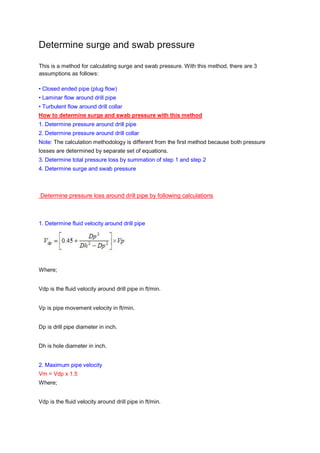Recommended
More Related Content
What's hot
What's hot (20)
Fluid flow phenomenon, prepared by Makhdoom ibad ullah hashmi

Fluid flow phenomenon, prepared by Makhdoom ibad ullah hashmi
Drainage Engineering (volume elasticity of aquifers)

Drainage Engineering (volume elasticity of aquifers)
Viewers also liked
Viewers also liked (13)
Similar to 5306066d02
Similar to 5306066d02 (20)
Lab 2 Fluid Flow Rate.pdfMEE 491 Lab #2 Fluid Flow Rate .docx

Lab 2 Fluid Flow Rate.pdfMEE 491 Lab #2 Fluid Flow Rate .docx
2A- Hydraulics, Water Distribution and WW Collection_AC_W2022 (1).pdf

2A- Hydraulics, Water Distribution and WW Collection_AC_W2022 (1).pdf
Calculation of Flowrate and Pressure Drop Relationship for Laminar Flow using...

Calculation of Flowrate and Pressure Drop Relationship for Laminar Flow using...
Rev. August 2014 ME495 - Pipe Flow Characteristics… Page .docx

Rev. August 2014 ME495 - Pipe Flow Characteristics… Page .docx
measurement of the flow of fluid by the venturimeter and the pitot tube and ...

measurement of the flow of fluid by the venturimeter and the pitot tube and ...
Investigation on Divergent Exit Curvature Effect on Nozzle Pressure Ratio of ...

Investigation on Divergent Exit Curvature Effect on Nozzle Pressure Ratio of ...
5306066d02
- 1. Determine surge and swab pressure This is a method for calculating surge and swab pressure. With this method, there are 3 assumptions as follows: • Closed ended pipe (plug flow) • Laminar flow around drill pipe • Turbulent flow around drill collar How to determine surge and swab pressure with this method 1. Determine pressure around drill pipe 2. Determine pressure around drill collar Note: The calculation methodology is different from the first method because both pressure losses are determined by separate set of equations. 3. Determine total pressure loss by summation of step 1 and step 2 4. Determine surge and swab pressure Determine pressure loss around drill pipe by following calculations 1. Determine fluid velocity around drill pipe Where; Vdp is the fluid velocity around drill pipe in ft/min. Vp is pipe movement velocity in ft/min. Dp is drill pipe diameter in inch. Dh is hole diameter in inch. 2. Maximum pipe velocity Vm = Vdp x 1.5 Where; Vdp is the fluid velocity around drill pipe in ft/min.
- 2. Vm is maximum pipe velocity. 3. Determine n Where; n is the power law exponent. Θ600 is a value at 600 viscometer dial reading. Θ300 is a value at 300 viscometer dial reading. 4. Determine K Where; K is the fluid consistency unit. Θ300 is a value at 300 viscometer dial reading. n is the power law exponent. 5. Determine shear rate of drilling mud moving around drill pipe Where;
- 3. Ym is shear rate of drilling mud moving around drill pipe. Vm is maximum pipe velocity. Dp is drill pipe diameter in inch. Dh is hole diameter in inch. 6. Determine shear stress of drilling mud moving around drill pipe T= K (Ym)n Where; T is shear stress of drilling mud moving around drill pipe. K is the fluid consistency unit. Ym is shear rate of drilling mud moving around drill pipe. n is the power law exponent. 7. Determine pressure loss around drill pipe Where; Pdp is pressure loss around drill pipe.
- 4. T is shear stress of drilling mud moving around drill pipe. Dp is drill pipe diameter in inch. Dh is hole diameter in inch. Ldp is drill pipe length in ft. Determine pressure loss around drill collar by following equations. 1. Determine fluid velocity around drill collar Where; Vdc is the fluid velocity around drill collar in ft/min. Vp is pipe movement velocity in ft/min. Dc is drill collar diameter in inch. Dh is hole diameter in inch. 2. Maximum pipe velocity Vm = Vdc x 1.5 Where; Vdc is the fluid velocity around drill collar in ft/min. Vm is maximum pipe velocity.
- 5. 3. Determine equivalent flow rate in gpm due to pipe movement Where; Q is equivalent mud flow rate in gpm. Vm is maximum pipe velocity. Dc is drill collar diameter in inch. Dh is hole diameter in inch. 4. Determine pressure loss around drill collar Where; Pdc is pressure loss around drill collar in psi. MW is mud weight in ppg. Q is equivalent mud flow rate in gpm. PV is plastic viscosity in cp. Ldc is length of drill collar in ft. Dh is hole diameter in inch. Ddc is drill collar diameter in inch.
- 6. The summation of pressure loss around drill pipe and drill collar is total pressure loss. Total pressure loss = Pdp + Pdc Surge pressure = Hydrostatic pressure + Total pressure loss Swab pressure = Hydrostatic pressure – Total pressure loss
